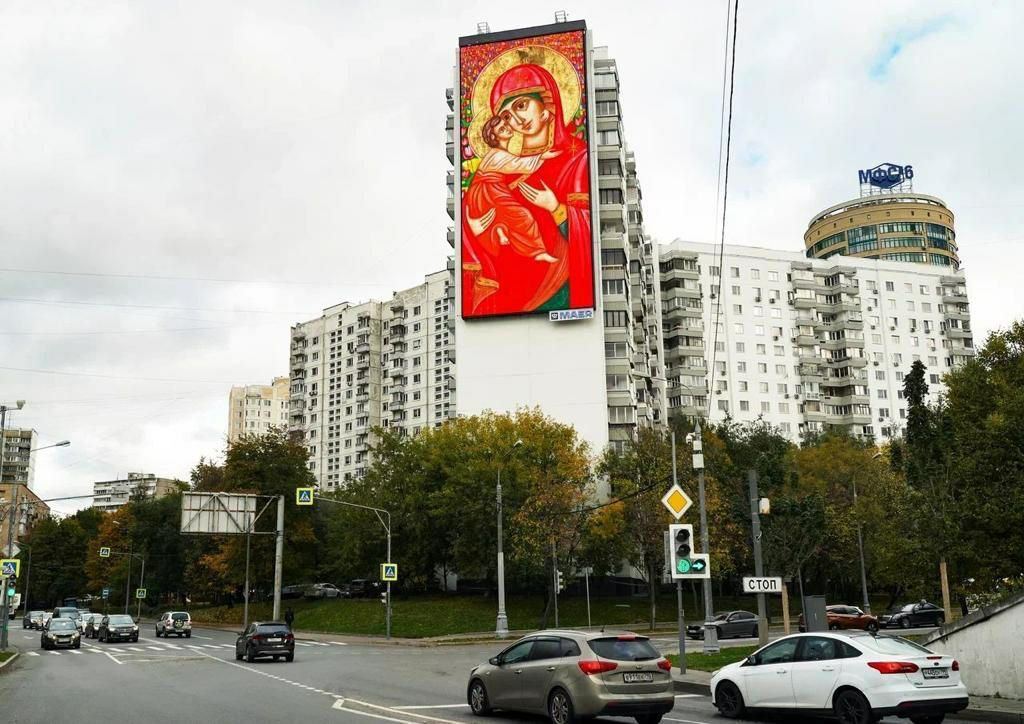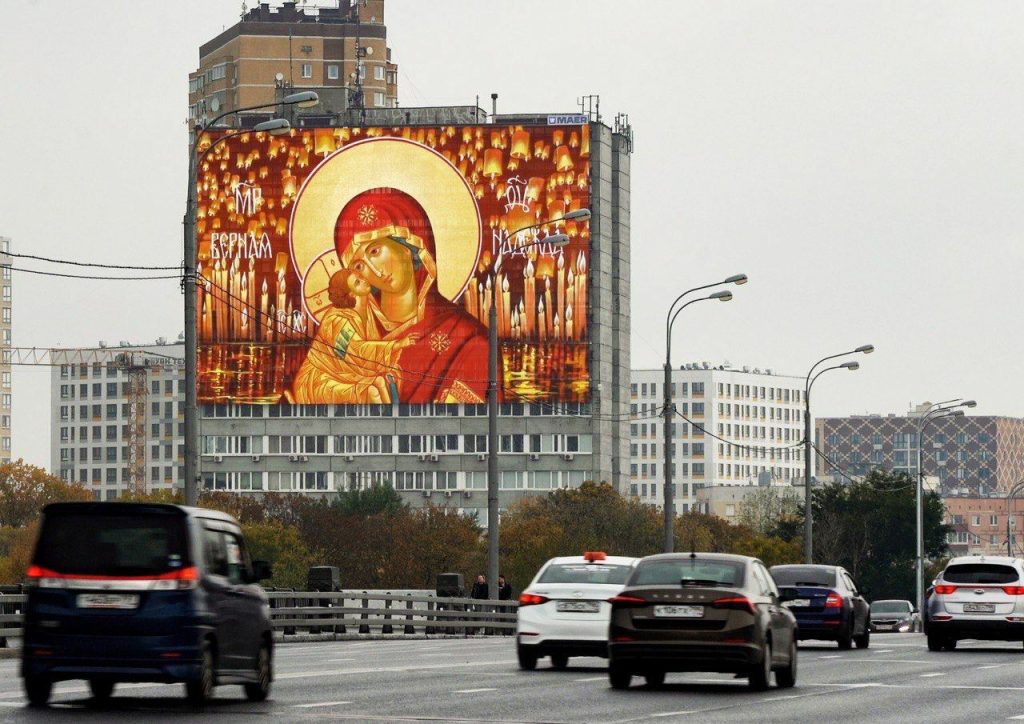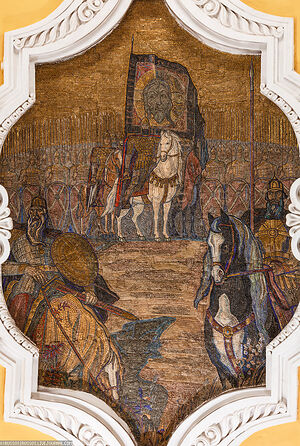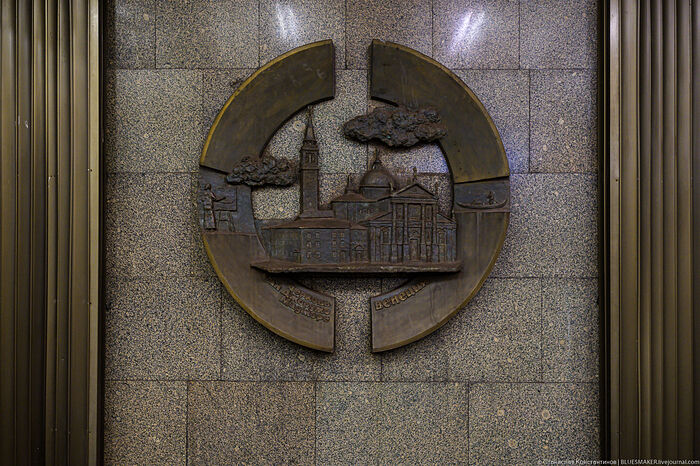October 15, 2022
In Moscow, some advertising billboards have been replaced with Orthodox Christian icons of Mary. God and family.

 This appears to be an interesting new development. Especially in a country considered Communist.
This appears to be an interesting new development. Especially in a country considered Communist.
If these are normally advertising billboards, what has changed?
I took the time to do some research on this, and a friend (Ginger Falcon) discovered a fascinating report ahead of me. (Included below for your reference).
Ginger states; “I feel deeply moved that something profound is going on in Russia!!!”
What are your thoughts? Discuss in the comments.
~~~ Linda Forsythe
6/25/22
Did you know that the Lord Jesus Christ is depicted at two stations of the Moscow Metro, that two stops of the subway bear the names of Orthodox feasts, and that the names of three stations include saints’ names? And finally, that Orthodox churches andl monasteries are depicted on the walls of ten metro stations? This article will tell you how the transport heart of the Russian capital has incorporated the symbols of Christianity.
How an Image of Christ Appeared in the Subway
 Mosaic of Komsomolskaya Koltsevaya (of the Circle Line) Metro StationIn 1952, the artist Pavel Dmitrievich Korin (1892-1967), who came from a family of icon-painters, depicted the image of Christ the Savior, “Not-Made-by-Hands”, on the vaults of the Moscow Komsomolskaya Koltsevaya Metro Station. On one of the mosaic plafonds a banner with an image of Christ is held by the holy Prince Alexander Nevsky, behind whom is the Novgorod Cathedral of Holy Wisdom. On another mosaic a banner with the Lord’s image flutters in the hands of the Right-Believing Prince Dimitry Donskoy, who arrived with the army on Kulikovo Field. And the third mosaic depicts the liberation of Moscow from the heretical Polish invaders by the All-Volunteer Army gathered by Kuzma Minin and Prince Dimitry Pozharsky. Both stand under a banner with the image of Christ “Not-Made-by-Hands,” with the Holy Protection Cathedral—with clearly distinguishable Orthodox crosses—behind them and golden crosses shining on their chests. Banners with the Sign of the Cross also flutter on the plafonds depicting the great Russian military commanders Suvorov and Kutuzov.
Mosaic of Komsomolskaya Koltsevaya (of the Circle Line) Metro StationIn 1952, the artist Pavel Dmitrievich Korin (1892-1967), who came from a family of icon-painters, depicted the image of Christ the Savior, “Not-Made-by-Hands”, on the vaults of the Moscow Komsomolskaya Koltsevaya Metro Station. On one of the mosaic plafonds a banner with an image of Christ is held by the holy Prince Alexander Nevsky, behind whom is the Novgorod Cathedral of Holy Wisdom. On another mosaic a banner with the Lord’s image flutters in the hands of the Right-Believing Prince Dimitry Donskoy, who arrived with the army on Kulikovo Field. And the third mosaic depicts the liberation of Moscow from the heretical Polish invaders by the All-Volunteer Army gathered by Kuzma Minin and Prince Dimitry Pozharsky. Both stand under a banner with the image of Christ “Not-Made-by-Hands,” with the Holy Protection Cathedral—with clearly distinguishable Orthodox crosses—behind them and golden crosses shining on their chests. Banners with the Sign of the Cross also flutter on the plafonds depicting the great Russian military commanders Suvorov and Kutuzov.
These amazing mosaics reflected the break in the official attitude of the Soviet authorities to the history of Russia—and then to the Orthodox Church—which occurred in 1941. When the war with Nazi Germany (the main goal of which was the destruction of the Russian people) broke out, it became clear that Russian soldiers were ready to sacrifice their lives only for their ancestral fatherland. And then Stalin said these words on Red Square: “Let the valiant images of our great ancestors—Alexander Nevsky, Dimitry Donskoy, Kuzma Minin, Dimitry Pozharsky, Alexander Suvorov and Mikhail Kutuzov—inspire you in this war!”
 Komsomolskaya Koltsevaya Metro Station
Komsomolskaya Koltsevaya Metro Station
Even during the war, in 1943, the profiles of all the above listed military commanders were depicted on bronze shields at the Novokuznetskaya Metro Station. But on the mosaics by P. Korin at the Komsomolskaya Koltsevaya Station they no longer appear as mere warriors, but as defenders of Holy Russia, clutching Christ’s image in their hands. And on the six side mosaics shines an image of the holy Great-Martyr George the Victorious, the heavenly patron of Christian hosts.
It was the labor of faith of P. Korin, the well-known author of the painting, “Requiem” (“Disappearing Russia.”) Thanks to his efforts the Lord’s image appeared for the first time at the largest of the columned stations of the capital’s Metro, blessing “disappearing Russia” to return and once again become a stronghold of the True Faith on earth.
The path of Russia’s return to faith was the path of the penitential understanding of everything that had happened to our people in the twentieth century. So it is no coincidence that Christ’s image reappeared in the Moscow Metro at the station dedicated to the writer for whom repentance was the main theme of his life and work–Fyodor Mikhailovich Dostoevsky.
 Dostoevskaya Metro Station
Dostoevskaya Metro Station
Dostoevskaya Metro Station was opened in 2010. Working on its design, the Russian artists Ivan Valentinovich Nikolaev (1940–2021) and Marina Dedova carefully re-read the writer’s books.
A passenger entering the station sees a picture of the ongoing war between good and evil in the hearts of Dostoevsky’s characters. The first image of Christ at Dostoevskaya is an illustration of the place from the novel Crime and Punishment where Sonya Marmeladova reads to Raskolnikov—whose soul is being tormented by the murder he has committed—the Gospel passage about the Lord’s raising of Lazarus, who had been dead for four days. We see the second image of Christ on the panel dedicated to “The Legend of the Grand Inquisitor” from the novel The Brothers Karamazov. In this parable by Dostoevsky Christ appears in the allegedly “Christian” West, where He is immediately arrested because the words of Truth interfere with the hypocritical builders of “Paradise on earth.” And the Heavenly King again appears before the court of this world, which condemns Him to death.
 Dostoevskaya Metro Station
Dostoevskaya Metro Station
The artist Nikolaev, who transferred these pages from Dostoevsky’s books to the Metro walls, spoke about their author: “He is called a prophet, and his Christian position is the foundation of his works.” And at Dostoevskaya Station a passenger especially believes that Russia will remain in this position forever.
From the Transfiguration to the Meeting
In 1965, a new Metro station—under the pretext of the construction of which the Church of the Transfiguration of the Lord was blown up in Moscow—was called, due to an oversight of the atheistic authorities, Preobrazhenskaya Ploshchad (“Transfiguration Square.”) Like many stations of the subway built at that time, it does not stand out by original architecture, but its name was unique until recently because it reminded us of one of the major feasts of the Orthodox Church.
In 1990, the local community of the faithful set up a commemorative cross on the square next to the Metro station, and the long journey of the church’s reconstruction began. Finally, in 2015, the Church of the Transfiguration of the Lord reappeared on the capital’s Transfiguration Square. Now it has the status of the church of Russia’s Ground Forces, since it was originally a regimental church of the Preobrazhensky Regiment.
 Sretensky Bulvar Metro Station
Sretensky Bulvar Metro Station
Another Orthodox feast, especially dear to the Russian capital’s residents, is reflected in the name of the Sretensky Bulvar Metro Station.
In the summer of 1395, Moscow was in turmoil: news came from the south that the great conqueror Timur (Tamerlane) was coming to Russia, having defeated Khan Tokhtamysh —whose tributaries were all Russian princes—in the Caucasus.
On learning of this, Grand Prince Vasily I, the son of Right-Believing Prince Dimitry Donskoy, having no other recourse, decided to resort to God’s help. It was decided to bring the wonder-working Vladimir Icon of the Mother of God from Vladimir to Moscow and implore Her to intercede for the Christian people before the throne of the Heavenly King. Then all the Muscovites came out to meet the icon of the Queen of Heaven with prayer. And soon it became known that Timur had unexpectedly turned his army to the south and was leaving the Russian lands. Two years later, on the site where the nationwide prayer service had been held in front of the miraculous icon, Sretensky Monastery was founded. then Sretenka Street appeared, and after it Sretensky Boulevard in the nineteenth century, and finally in 2007 the Metro station with the same name opened.
Here an ancient church shows through Nikolai Gogol’s figure with his question: “Russia, where are you hastening?” and above the words from Vladimir Vysotsky’s song—the silhouette of a bell tower covered in gold. At this station Rus’ meets the future Russia, and everything indicates that this meeting has taken place.
From Vladykino to Troparevo
 Vladykino Metro Station
Vladykino Metro Station
Since ancient times in Russia Church hierarchs have been called “Vladyka.” “Master (“Vladyka”), bless,” the deacon proclaims as he steps onto the solea at the beginning of the Divine Liturgy. From this term comes the name of the Vladykino Metro station.
About four centuries ago, the village, which gave its name to the Moscow district, and then to the Metro station of the same name, belonged to His Holiness (“Vladyka”) Patriarch Nikon, whose name is associated not only with glorious, but also tragic events in the history of the Russian Church. Maybe that’s why the darkness of the walls of the Vladykino station is cut in several places by vertical stripes of marble with bronze images of churches. And next to the image of the Church of the Nativity of the Theotokos, His Holiness Vladyka Nikon himself is depicted.
Another liturgical term that adorned the Moscow metro map is reflected in the name “Troparevo”. The name of this Metro station, where beautiful trees made of glass and metal “grow” and shine, comes from the word “troparion.” Troparia are sacred hymns composed by the Church to reveal the spiritual meaning of the feasts dedicated to the Lord, the Most Holy Theotokos and all the saints.
 Troparevo Metro Station
Troparevo Metro Station
The history of the Troparevo district, where this Metro station is located, dates back to the time of the holy Metropolitan Alexei of Moscow, tutor to the Right-Believing Prince Dimitry Donskoy and the de facto ruler of Muscovite Russia during the Prince’s childhood. One of Metropolitan Alexei’s employees was the boyar Ivan Mikhailovich, who loved church services so much that he was nicknamed “Tropar” (“troparion.”) Ivan Tropar was an outstanding Russian diplomat. In 1357, he accompanied the Primate of the Russian Church during his famous journey to the capital of the Golden Horde, where St. Alexei by his prayer restored sight to Taidula, the Khan’s mother. In gratitude for his mother’s healing Khan Jani Beg exempted all the possessions of the Russian Church from paying tribute, including the boyar-diplomat Ivan Tropar.
In 1372, for his involvement in the conclusion of a peace treaty with the Principality of Lithuania, Ivan Tropar was granted a village, which received its owner’s name: Troparevo.Here the diplomat founded the Church of St. Michael and All the Bodiless Hosts, which he lived near until his death in 1393. And 620 years later the Troparevo Metro Station was built here. Its name reminds us of the love of our talented ancestors for Church hymns glorifying Christ.
Churches on the Walls
Images of Orthodox churches began to appear in the Moscow Subway back in Soviet times. The first were the Holy Protection Cathedral on Red Square and the Novgorod Cathedral of Holy Wisdom, laid out from the mosaic by P. Korin at Komsomolskaya Koltsevaya Station. However, in the decades that followed the Church was passed over in silence, and the theme of Russian history, inseparable from Orthodoxy, was avoided in the designs of the stations. But gradually everything began to change, and in 1983 this was demonstrated on the panels of Nagatinskaya Station.
Their author, Leonid Nikolaevich Pavlov (1909-1990), was in love from his youth with the architecture of ancient Russian churches, and dreamed of bringing elements of their designs to the Moscow Metro. And he was brilliantly successful at Dobryninskaya Station, as the basis of the proportions of which he put the proportions of the Church of the Protection of the Theotokos on the Nerl [in Bogolyubovo, the Vladimir region.—Trans.]. The young architect visited it and even spent a night on the bell tower (converted into a hayloft in the Soviet era) to watch how the marvelous church walls turned first pink, then white at dawn.
 Nagatinskaya Metro Station
Nagatinskaya Metro Station
“I discovered the amazing laws of proportionality in Russian architecture,” Pavlov related. “At Nagatinskaya Station I tried to convey this theme in simple, powerful pillars—like those typical for the cathedrals of Novgorod. The columns I conceived turned out to be hard to implement. Nevertheless, I insisted on my plan. With difficulty I managed to defend putting the mosaic on the track walls, which, I was told, are supposedly always hidden from passengers’ eyes by trains. I argued that when people are waiting for a train, they look at nothing other than the walls behind the tracks. The artists Eleonora Zharenova and Vladimir Vasiltsov understood me perfectly, doing a beautiful, warm Florentine-style mosaic.”
 Nagatinskaya Metro Station
Nagatinskaya Metro Station
If you spend ten minutes looking at the walls along this station’s tracks, without getting onto any trains, the history of Russian architecture will unfold before you. Here, against the twilight background, huge crimson flames flicker in memory of how often towns and villages in ancient Russia with their wooden buildings were destroyed by fire. Here a bricklayer works with a trowel, a bell-ringer strikes a bell, and the Cathedral of the Archangel Michael—with crosses—already rises. On another panel you can see the bell tower of Ivan the Great, also with a cross with subtle details. Here is a prince with his retinue at the walls of the white-stone Kremlin, with a church in its center; here is an architect in a caftan with his plan, and behind him is the Holy Protection Cathedral (“St. Basil’s”) on Red Square. And here are both the coat-of-arms of Moscow—St. George vanquishing the dragon—and the Kremlin, on the towers of which there are no stars, but clearly recognizable eagles.
 Borovitskaya Metro Station
Borovitskaya Metro Station
Only three years passed, and the theme of Russian architecture was continued in the design of Borovitskaya Station, situated almost at the Kremlin walls. That was the first of the Metro monumental masterpieces by the remarkable artist I. Nikolaev. On Borovitskaya’s end wall he depicted the “Friendship Tree of the Soviet Peoples,” the roots of which stem from the Kremlin. All his cathedrals are crowned with eight-pointed Orthodox crosses. And the station’s red-brick walls are decorated with ornamental tiles, on one of which is the Holy Protection Cathedral on Red Square (commonly known as St. Basil’s Cathedral). This is its third appearance in the subway.
In the spring of 1991, just before the collapse of the atheistic dictatorship, at the newly opened Vladykino and Otradnoye Metro stations passengers saw symbols of Christianity rapidly entering the vast country’s life.
On the walls of Vladykino Station we see the Church of the Nativity of the Theotokos in Vladykino, the Chapel of the Archangel Michael in Kizhi, the Deposition of the Robe of the Theotokos Church-Over-the-Golden-Gate in Vladimir, and the Nikortsminda Georgian St. Nicholas Cathedral. The thirst for religious freedom was so great that the artist Anatoly Mefodyevich Mosiychuk (1942-2013) also depicted here a Catholic cathedral, a Sufi madrasah and a Sunni mosque.
At the same time, Otradnoye Metro Station was opened to the design of I. Nikolaev. All the paintings at this station are dedicated to the tragic event in Russian history known as the Decembrist Revolt [December 26, 1825 in Senate Square of St. Petersburg.—Trans.] This attempted coup d’etat, aimed at rebuilding Russia in Western style, was decisively suppressed by the young Emperor Nicholas I.
 Otradnoe Metro Station
Otradnoe Metro Station
Many Decembrists, exiled to hard labor, reconsidered their views and became deeply religious people. So at Otradnoye Station, next to a prison, there is a large image of an eight-pointed Orthodox cross and the Church of St. Michael the Archangel in Nerchinsk [in the Chita region.—Trans.], where the Decembrist Ivan Annenkov and Pauline Gebl (who followed him and converted to Orthodoxy with the name Paraskeva) were married. Few people know that on hearing about her desire to link her destiny with the convict, Nicholas I sent her 3,000 rubles, in fact ensuring her a comfortable life in a harsh land.
The next time images of churches appeared in the Metro was for the 850th anniversary of Moscow. In 1997, when the southern lobby appeared at VDNKh station, it was decorated with an elegant Gzhel panel, “Fair in Zamoskvorechye [a historic district in central Moscow, meaning “beyond the Moskva River”—Trans.] On it, folk festivals are taking place within the borders of six churches, among which the artists A.V. Tsaregorodtsev and M.V. Podgornaya depicted the Cathedral of Christ the Savior and Novodevichy Convent.
 Gzhel panel, “Fair in Zamoskvorechye.” The decoration of the southern lobby of VDNKh Metro Station is a ceramic Gzhel panel, “Fair in Zamoskvorechye.” The authors are artists M.V. Podgornaya and A.V. Tsaregorodtsev.
Gzhel panel, “Fair in Zamoskvorechye.” The decoration of the southern lobby of VDNKh Metro Station is a ceramic Gzhel panel, “Fair in Zamoskvorechye.” The authors are artists M.V. Podgornaya and A.V. Tsaregorodtsev.
In 2007, Zurab Tsereteli, the author of the design of Trubnaya Metro Station, came up with a very good idea: to depict on twelve stained-glass windows with illumination the architecture of the cities and towns of the “Golden Ring” of Russia: Moscow, Vladimir, Veliky Novgorod, Pskov, Rostov Veliky, Pereslavl-Zalessky, Suzdal’ and Yaroslavl’, as well as the Russian villages of Palekh, Bogolyubovo and Kolomenskoye. Thanks to this, the Metro station was enriched with images of masterpieces of Russian church architecture, but one thing is not good: only the Church of the Ascension of the Lord in Kolomenskoye has a cross.
 Maryina Roshcha Metro Station
Maryina Roshcha Metro Station
The picturesque mosaics of Maryina Roshcha Metro Station, which opened in 2010, are stunning. With great love and gentle Nesterov-style colors, the artist Sergey Vitalyevich Goryayev (1958-2013) depicted the Central Russian nature—forests and meadows—that once covered this area. And in almost all the paintings we see—now far, now close—an image of Orthodox holiness: the Churches of the Holy Martyr Tryphon, of the Icon of the Mother of God “Unexpected Joy,” of the Descent of the Holy Spirit upon the Apostles at the Lazarevsky Cemetery, and the Holy Trinity in Ostankino.
The same technique was used in the Metro for the design closest to us in time, celebrating Orthodox shrines: this is the design of Belomorskaya Station, built in the capital’s north in 2018. On the large mosaic panels, made by a team of artists headed by Maxim Kozlov, the majestic polar lights shine, the Solovki Monastery is gently reflected in the water with its walls and domes, glorious Valaam stands level with the clouds, and of course, Kizhi.
Saints’ Names on the Metro Map
Few people passing Alexeyevskaya Station know that it owes its name to St. Alexis Man of God. In 1648, the local church was dedicated in honor of this amazing ascetic, who left his home and the blessings of this world for the sake of the Kingdom of Heaven.
St. Alexis was the patron saint of the Russian Tsar Alexei Mikhailovich, who loved to go hunting in the vast forests that covered this area in the seventeenth century. In 1670, a royal palace was built on this site for when the Tsar was travelling, connected by a passage to St. Alexis Church so the Tsar could come and pray at the church of his patron saint any time. From that time on the village began to be called Alexeyevskoye.
In 1812, Napoleon’s troops set up a warehouse and a stable in St. Alexis Church and in the neighboring Church of the Tikhvin Icon. When Emperor Alexander I ordered that funds be allocated from the treasury for the reconstruction of the churches, the dilapidated St. Alexis Church was dismantled, and the bell tower of the Church of the Tikhvin Icon was built with its stone.
Centuries later, urban quarters replaced the forests, and the name Alexeyevsky passed to Moscow’s new district and Metro station.
And at the beginning of the twenty-first century, the names of some holy God-pleasers finally appeared on the Moscow Metro map. The first of them is the Right-Believing Prince Dimitry Ivanovich Donskoy.
In 2002, the Moscow Metro went beyond the Moscow Automobile Ring Road (MKAD). And how symbolic it is that the first station built on this new frontier was called Dmitry Donskoy Bulvar.
 The “Prince” and “Princess” sculpturesAt the entrance to the station you can see a memorial stone with an image of the holy defender and builder of Moscow, and next to him an image of St. Sergius of Radonezh blessing Prince Dimitry for the battle with Mamai, who intended to destroy the Russian Christian civilization. A little further, on the boulevard of the same name next to the station is a sculptural composition depicting the Right-Believing Prince Dimitry and his wife, the holy Princess Eudoxia. After her husband’s death she became the ruler of Muscovite Russia, secretly leading an ascetic life, and when her sons came of age, she took monastic vows in the Ascension Convent founded by her with the name Euphrosyne.
The “Prince” and “Princess” sculpturesAt the entrance to the station you can see a memorial stone with an image of the holy defender and builder of Moscow, and next to him an image of St. Sergius of Radonezh blessing Prince Dimitry for the battle with Mamai, who intended to destroy the Russian Christian civilization. A little further, on the boulevard of the same name next to the station is a sculptural composition depicting the Right-Believing Prince Dimitry and his wife, the holy Princess Eudoxia. After her husband’s death she became the ruler of Muscovite Russia, secretly leading an ascetic life, and when her sons came of age, she took monastic vows in the Ascension Convent founded by her with the name Euphrosyne.
And finally, in 2003, one of the modern surface-level stations of the same Metro line was named after an absolutely amazing saint—the Heavenly patron of the Russian Navy, the Righteous Admiral Fyodor Ushakov. It is known that, despite the many battles in which he won even when it seemed impossible, not a single one of his subordinates was captured, and not a single ship was sunk. Sailors called the righteous admiral “father” because he set a touching example of care for ordinary sailors. Ushakov did not attribute a single victory to his military skills, but he saw in them only God’s help and always gave thanks to the Lord.
From the platform of Admiral Ushakov Bulvar Station you can see the domes of the Church of the Holy Righteous Warrior Fyodor. And not only the rumble of passing trains resound far away in the district, but also the chime of bells, reminding us of the words of the invincible commander of the Russian Navy: “These thunderstorms will turn to the glory of Russia!”
6/25/2022
News Stories Researched and Posted by our Team of Volunteer Citizen Journalists


